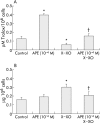Apple polyphenol extracts prevent damage to human gastric epithelial cells in vitro and to rat gastric mucosa in vivo
- PMID: 15647180
- PMCID: PMC1774853
- DOI: 10.1136/gut.2004.046292
Apple polyphenol extracts prevent damage to human gastric epithelial cells in vitro and to rat gastric mucosa in vivo
Abstract
Background: Fresh fruit and vegetables exert multiple biological effects on the gastrointestinal mucosa.
Aim: To assess whether apple extracts counteract oxidative or indomethacin induced damage to gastric epithelial cells in vitro and to rat gastric mucosa in vivo.
Methods: Apple extracts were obtained from freeze dried apple flesh of the "Annurca" variety. Cell damage was induced by incubating MKN 28 cells with xanthine-xanthine oxidase or indomethacin and quantitated by MTT. In vivo gastric damage was induced by indomethacin 35 mg/kg. Intracellular antioxidant activity was determined using the (2,2'-azinobis (3-ethylbenzothiazolin-6-sulfonate) method. Malondialdehyde intracellular concentration, an index of lipid peroxidation, was determined by high pressure liquid chromatography with fluorometric detection.
Results: (1) Apple extracts decreased xanthine-xanthine oxidase or indomethacin induced injury to gastric epithelial cells by 50%; (2) catechin or chlorogenic acid (the main phenolic components of apple extracts) were equally effective as apple extracts in preventing oxidative injury to gastric cells; and (3) apple extracts (i) caused a fourfold increase in intracellular antioxidant activity, (ii) prevented its decrease induced by xanthine-xanthine oxidase, (iii) counteracted xanthine-xanthine oxidase induced lipid peroxidation, and (iv) decreased indomethacin injury to the rat gastric mucosa by 40%.
Conclusions: Apple extracts prevent exogenous damage to human gastric epithelial cells in vitro and to the rat gastric mucosa in vivo. This effect seems to be associated with the antioxidant activity of apple phenolic compounds. A diet rich in apple antioxidants might exert a beneficial effect in the prevention of gastric diseases related to generation of reactive oxygen species.
Figures







Similar articles
-
Effect of reddening-ripening on the antioxidant activity of polyphenol extracts from cv. 'Annurca' apple fruits.J Agric Food Chem. 2007 Nov 28;55(24):9977-85. doi: 10.1021/jf071773a. Epub 2007 Oct 26. J Agric Food Chem. 2007. PMID: 17960886
-
Apple peel polyphenols protect against gastrointestinal mucosa alterations induced by indomethacin in rats.J Agric Food Chem. 2011 Jun 22;59(12):6459-66. doi: 10.1021/jf200553s. Epub 2011 May 19. J Agric Food Chem. 2011. PMID: 21548634
-
Protection by apple peel polyphenols against indometacin-induced oxidative stress, mitochondrial damage and cytotoxicity in Caco-2 cells.J Pharm Pharmacol. 2010 Jul;62(7):943-50. doi: 10.1211/jpp.62.06.0017. J Pharm Pharmacol. 2010. PMID: 20636884
-
Role of oxygen radical and lipid peroxidation in indomethacin-induced gastric mucosal injury.Dig Dis Sci. 1998 Sep;43(9 Suppl):30S-34S. Dig Dis Sci. 1998. PMID: 9753223 Review.
-
Phytochemicals enhance antioxidant enzyme expression to protect against NSAID-induced oxidative damage of the gastrointestinal mucosa.Mol Nutr Food Res. 2017 Jun;61(6). doi: 10.1002/mnfr.201600659. Epub 2017 Jan 31. Mol Nutr Food Res. 2017. PMID: 27883262 Review.
Cited by
-
Protection of Polyphenols against Glyco-Oxidative Stress: Involvement of Glyoxalase Pathway.Antioxidants (Basel). 2020 Oct 16;9(10):1006. doi: 10.3390/antiox9101006. Antioxidants (Basel). 2020. PMID: 33081239 Free PMC article.
-
The protective effects of Prunus armeniaca L (apricot) against methotrexate-induced oxidative damage and apoptosis in rat kidney.J Physiol Biochem. 2013 Sep;69(3):371-81. doi: 10.1007/s13105-012-0219-2. Epub 2012 Nov 10. J Physiol Biochem. 2013. PMID: 23143813
-
Paeonin extracted from potatoes protects gastric epithelial cells from H2O2-induced oxidative damage in vitro by PI3K/Akt-mediated Nrf2 signaling pathway.Sci Rep. 2018 Jul 18;8(1):10865. doi: 10.1038/s41598-018-28772-5. Sci Rep. 2018. PMID: 30022028 Free PMC article.
-
Scientific evaluation of edible fruits and spices used for the treatment of peptic ulcer in traditional Iranian medicine.ISRN Gastroenterol. 2013 Aug 26;2013:136932. doi: 10.1155/2013/136932. ISRN Gastroenterol. 2013. PMID: 24066235 Free PMC article. Review.
-
Gastroprotective Effects of Paeonia Extract Mixture HT074 against Experimental Gastric Ulcers in Rats.Evid Based Complement Alternat Med. 2019 Feb 17;2019:3546258. doi: 10.1155/2019/3546258. eCollection 2019. Evid Based Complement Alternat Med. 2019. PMID: 30906413 Free PMC article.
References
-
- Mizui T , Sato H, Hirose F, et al. Effect of antiperoxidative drugs on gastric damage induced by ethanol in rats. Life Sci 1987;41:755–63. - PubMed
-
- Pihan G , Regillo C, Szabo S. Free radicals and lipid peroxidation in ethanol- or aspirin-induced gastric mucosal injury. Dig Dis Sci 1987;32:1395–401. - PubMed
-
- Szelenyi I , Brune K. Possible role of oxygen free radicals in ethanol-induced gastric mucosal damage in rats. Dig Dis Sci 1988;33:865–71. - PubMed
MeSH terms
Substances
LinkOut - more resources
Full Text Sources
Other Literature Sources
